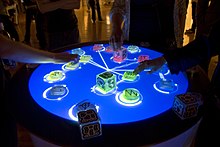Tangible user interface

A tangible user interface is a tangible user interface that allows a computer user to interact with the machine through physical objects. Often, the acronym is TUI used ( engl. T angible U ser I nterface). The term “Graspable User Interface” was used in some initial works, but was later completely replaced by “Tangible User Interface”. In the German-speaking world, the terms “objective user interface” and “tangible interaction” are also used synonymously.
Interaction model
An interaction model, Model-Control-Representation (Physical and digital), MCRpd, developed for Tangible User Interfaces, is a modification of the Model View Controller model known from software development . It is assigned three key characteristics.
- Physical objects (physical representation) are linked to digital information (model).
- Physical objects contain and implement mechanisms for interactive control.
- The physical representation is perceptibly linked to the currently transmitted digital information.
Another key characteristic applies to TUIs, which is not shown in the model described above.
features
The following aspects are characteristic of the interaction between a TUI and the user or the digital system linked to the TUI:
- "Tangible manipulation": physical objects are manipulated by a person, i. H. moved, rotated, lifted etc.
- "Spatial Interaction": physical objects exist in real space, i. In other words, they are subject to the laws of the environment and happen in three-dimensional space (even if some projects use TUIs for manipulation in one plane).
- "Embodied Facilitation": The interaction with TUI has an equivalent in the digital world; its constellation and grouping in the physical world has an impact on its functionality.
- "Expressive Representation": Material, form and digital functionality define the interaction with TUI as a unit.
A computer mouse is not a tangible user interface because it processes abstract inputs regardless of the application domain.
development
One of the earliest and most widely observed examples of TUIs is the Marble Answering Machine by Durrell Bishop (1992), even if it is only one of a number of interrelated objects (Ecology). This is an answering machine . Each call is (with a ball engl. Marble) is linked, which falls out of the answering machine. If this is stored at a certain point, the message is played or the caller is called back. The Marble Answering Machine graces, in honor of its importance for the research area of the TUIs, z. B. the cover picture of the proceedings of the first conference of the TEI series.
Leading pioneers in this field are Hiroshi Ishii and Brygg Ullmer of the Massachusetts Institute of Technology Media Lab. He recorded Ishii's vision for Tangible User Interface in his conference contribution Tangible Bits in 1997. In it, he describes the linking of digital information with physical objects that make the digital information directly perceptible and manipulable.
Fields of application for TUIs include urban planning (e.g. URP, see examples for TUIs below), industrial processes, but also in music, in the play area and in learning. A well-known TUI application is the Reactable, an electronic musical instrument with an intuitive tangible interface in which simple plastic objects emulate a modular synthesizer. The Icelandic singer Björk has been using a Reactable at her concerts since 2007 .
In early 2012, Ishii et al. proposed the idea of radical atoms. There they describe what, in their opinion, is the next step in the development of tangible user interfaces: away from tangible bits towards deformable materials that enable completely new interactions.
Web links
- Additional information
- Tangible Embedded and Embodied Interaction , International ACM Conference on the subject
- Tangible Media Group at MIT
- Tangint - Wiki from Brygg Ullmer's research group on Tangible User Interfaces and Tangible Interaction.
- TUIO - a community standard for the communication of touch input and markers for tangible user interfaces.
- Tangible Interaction - Section of the Human-Computer Interaction Department.
- Tangible Interaction - Research group on Tangible User Interfaces at TU Darmstadt.
- Examples of tangible user interfaces
- John Underkoffler and Hiroshi Ishii: Urp: a luminous-tangible workbench for urban planning and design
- Microsoft PixelSense [1]
- Reactable - a modular synthesizer with a tangible multitouch interface.
Individual evidence
- ↑ Ullmer, B., Ishii, H .: Emerging frameworks for tangible user interfaces. IBM Systems Journal 39 (2000), pp. 915-931
- ↑ Hornecker, E .: A design theme for tangible interaction: Embodied facilitation. In: Proceedings of ECSCW '05, Springer (2005), pp. 23-43
- ↑ Nicolas Villar, Pin & Play Interface Architecture ( Memento of the original from September 7, 2009 in the Internet Archive ) Info: The archive link has been inserted automatically and has not yet been checked. Please check the original and archive link according to the instructions and then remove this notice.
- ^ Crampton Smith, G .: The Hand That Rocks the Cradle. In: ID May / June 1995, pp. 60-65
- ↑ Cover picture of the proceedings ( Memento from December 17, 2012 in the web archive archive.today )
- ↑ Hiroshi Ishii and Brygg Ullmer: Tangible Bits: Towards Seamless Interfaces between People, Bits and Atoms ( Memento of the original from May 2, 2005 in the Internet Archive ) Info: The archive link was automatically inserted and not yet checked. Please check the original and archive link according to the instructions and then remove this notice. . Published in Proceedings of Human Factors in Computing Systems: CHI 97 ( Memento of the original from April 3, 2005 in the Internet Archive ) Info: The archive link was inserted automatically and has not yet been checked. Please check the original and archive link according to the instructions and then remove this notice. , Denver (Colorado)
- ↑ Hiroshi Ishii, Dávid Lakatos, Leonardo Bonanni, and Jean-Baptiste Labrune Radical Atoms: Beyond Tangible Bits, Toward Transformable Materials
